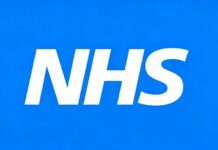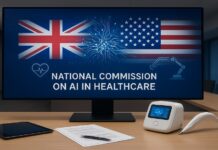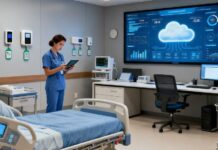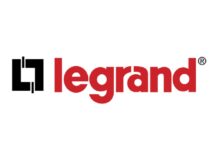From the TV show, “House”, the irascible but brilliant Doctor House tells a class of med students that they will make mistakes and they will lose lives and that they better get used to it or either find another job or become a teacher. The silence in the room was deafening. Tough words, but unfortunately they are very true. And the likelihood of making more mistakes that cost lives increases with the rapid introduction of millions of baby boomers as they enter their sixties and seventies. All of this is coming at a time of increasing healthcare costs, fewer numbers of hospitals as consolidation continues from the past decade, lack of an agreed upon national healthcare strategy, the crunch on Social Security and government medical programs like Medicare and Medicaid, and the overall economic malaise we find ourselves experiencing today.
Fewer hospitals are dealing with more patients, more diseases, more costs, and bigger headaches. The good news is that we have answers! We can save costs while saving lives.

Charles Olmeda is a Sr. Project Manager for Shipcom Healthcare Solutions focusing on delivering Automatic Identification Technology solutions to the healthcare industry, most recently as the Project Manager for a contract with a major Air Force Medical Center. Formerly an IBM Systems Engineer, Shared Medical Systems (now Siemens) Healthcare Systems Consultant and First Consulting Group Integration Manager. Before joining Shipcom Mr. Olmeda provided independent healthcare consulting and project management to various healthcare organizations, he has over twenty years in Healthcare Information Technology.E-Mail: colmeda@shipcomwireless.com
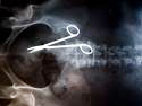
From the TV show, “House”, the irascible but brilliant Doctor House tells a class of med students that they will make mistakes and they will lose lives and that they better get used to it or either find another job or become a teacher. The silence in the room was deafening. Tough words, but unfortunately they are very true. And the likelihood of making more mistakes that cost lives increases with the rapid introduction of millions of baby boomers as they enter their sixties and seventies. All of this is coming at a time of increasing healthcare costs, fewer numbers of hospitals as consolidation continues from the past decade, lack of an agreed upon national healthcare strategy, the crunch on Social Security and government medical programs like Medicare and Medicaid, and the overall economic malaise we find ourselves experiencing today.
Answers are needed as at the statistics show that as healthcare needs increase, so do the errors, deaths, and lawsuits. DOA has succumbed all too often to DIH or died in hospital. Reports show 90,000 people had avoidable deaths in hospitals last year in the U.S.
Yet, there are answers. Healthcare beckons innovation.
There is one potential hero that could come to the rescue at a time of great need for the healthcare industry: Hybrid AIDC Technologies for Real Time Visibility (RTV). This is quite a mouthful.
Although most of us are familiar with bar codes (UPC or uniform product codes) and routinely manage them at the supermarket with coupons, or purchases in retail stores or self service POS (point of sale) in places like Home Depot and airline check-in kiosks. Interestingly, hospitals have yet to exploit what is known as automatic identification and data collection (AIDC) and one of its related technologies, RFID (radio frequency identification) which now have electronic product codes, formerly EPC, now GS1 or one global standard for the world.
As a result and one example, President Obama has repeatedly called for a national effort to convert paper documents to secure digital form (EMR or EHR: electronic medical or health records) that will allow uses not currently available in the health care industry, but is routine in other industries.
Bar codes can be used to track items in hospitals, especially medical supplies or pharmaceuticals in inventories, but even that is not commonly used. Just as many third world countries have bypassed the use of wired communications or landlines and have implemented wireless/cell phone technologies; hospitals now have the chance not to necessarily bypass bar codes, but to complement their use where it makes sense while exploiting the wireless world with RFID.
Not all RFID is the same. There is active, battery powered RF; there is passive, non-battery or backscatter RF; and RF used with different frequencies – all dependent on the application. In simple terms, RF Active is used when long range is needed and passive use is best when very low cost tags are needed. Then there is RTLS (real time locating system) that wirelessly transmits signals to read a tag, obtains an ID and then calculates (using triangulation) the location of the tag. But the list of applications is long, especially when including sensors for temperature, humidity, motion, or chemical presence.
So, for hospitals, we can deploy RFID, Bar Code and other sensor technologies to provide RTV for many specific medical applications. The first priority is to tag the items/people/assets that move or can move that can influence operational decisions. We have lots of opportunities to leverage these hybrid technologies to a hospital’s operational and financial advantage. Hospitals are bleeding, but they may not know how badly, where or for how long.
Let’s take a look at some specific examples of target applications…
-
General Asset Management of Medical and IT Equipment
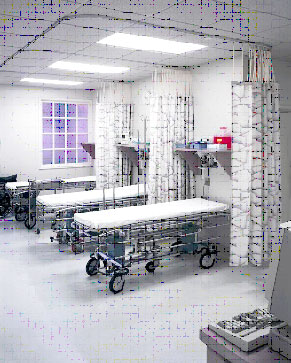
Hospitals across the nation are faced with an equipment financing and management squeeze. The expense of constantly buying new equipment can annually strain the finances of even the best managed healthcare organizations. Medical equipment that is essential to maintaining a high standard of patient care and competitive advantage also involves high cost and the complexity of maintaining and managing equipment that may affect the hospital operations and could divert valuable facility resources away from the core mission of patient care. A hospital, by using RFID or other sensor technologies, could enable the automated collection of asset information including location, maintenance status, and more without a person needing direct line of sight or contact with that asset. Once the sensor technology gathers data, the information is passed to the organization’s enterprise or asset management application. As a result, the system may trigger an alert, release a work order, update inventory, conduct inspections, create an invoice or locate an asset. Hospitals could experience improvements in productivity, reduce costs by implementing automated maintenance schedules rather than an arbitrary calendar-based schedule, increase revenue by accurately valuing assets being used, and increase equipment longevity by identifying usage patterns.
-
Patient Tracking/Flow
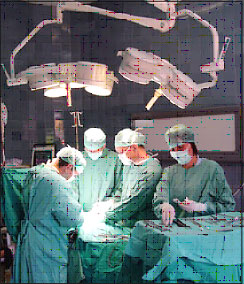
As the evolution of RFID moves forward, most hospitals are still waiting for continued technology development and for prices to perhaps inch downward. Experts in the industry estimate that only about 200 hospitals out of over 5,600 in the US are using automatic identification technology. Very few have implemented the technology for patient tracking to optimize patient flows, reduce wait times in waiting rooms and improve patient satisfaction. A small RFID tag on a patient wristband emits a radio wave that is detected by a network of receivers around the hospital. The system graphically displays the locations on a virtual map of the facility, or in a table view or into a hospital information system (HIMS). In the few situations where RFID has been implemented, it has mainly been for emergency departments, operating rooms or small pilot programs on a single floor. RFID technology for patient tracking improves and streamlines patient care processes by coordinating crucial events from patient admission to discharge processes, all while improving patient safety by giving hospital staff the real-time data and task coordination tools required to improve patient care.
-
Inventory Control
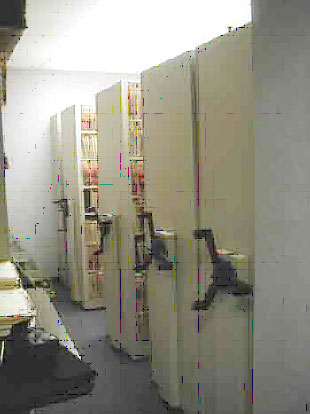
RFID technology has great potential in healthcare to significantly reduce cost, while improving materials management and inventory operations. Cost-conscious industries like retail and manufacturing traditionally have focused on using RFID systems to enhance the efficiency in supply management and logistics processes, including inventory control. Effective inventory management affects costs that can range 45-90% of total expenses. If the use of automatic identification technology can save just a percentage of that cost, the cost saving is real and drives to the bottom line profitability of the hospital. Use of RFID for managing and controlling inventory can provide more control over uses of capital that affects all departments. After all, why buy inventory when it is not needed. Overstocking is expensive. Also, having the right stock available at the right time is critical. A lack of RTV data on stock levels means that stocks often run low or even run out altogether, causing unnecessary disruption to operations. Additionally, staff normally must fill in paper-based forms so that supplies can be distributed to the wards or departments. This can waste valuable staff time and reduce hospital efficiency. RFID can provide real-time data on inventory logistics as items move from storage cabinets in the hospital and out to the wards and individual users, and back to storage if necessary.
-
Bedside Services
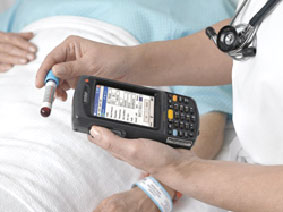
The escalation of healthcare costs has created market pressure to increase the efficiency of patient care while continuing to increase quality. One means of addressing that challenge has been the advancement of computing solutions in various digital health initiatives. RFID introduces a new approach involving proximity-detection and association of the patient to assets, items, caregivers and other points of concern with automatic detection and presentment. This approach enables a new generation of patient identification solutions for the healthcare industry that is going “digital”. An integrated patient-identification solution addresses the inefficiencies and potential for human error associated with traditional patient identification. Increased accuracy helps to avoid hospital liabilities associated with bedside services mistakes. While many hospitals are considering technology for patient identification, most hospitals have not considered automated patient association to create an audit trail with automated tracking and tracing and with a system of alarms/alerts when mistakes are anticipated or in progress.
-
Surgical Trays and Instruments, Track & Trace
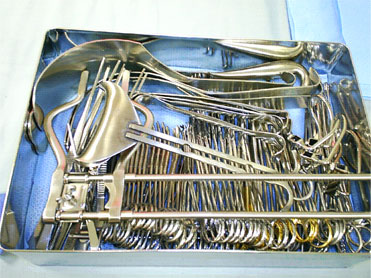
Surgical instrument storage and sterilization systems include surgical instrument trays and kits which typically consist of trays or boxes that hold a variety of general purpose and or specific surgical instruments such as forceps, scissors, clamps, retractors, scalpels, etc. These pre-prepared, surgery-specific instrument trays are brought into the operating room (OR) when preparing for surgery and are used as a means to organize and store surgical instruments. These trays are used to transport medical instruments within a hospital or even in and out of medical facilities. Advances in medical technology have created an enormous increase on the number and type of surgical instruments now in use. It has become necessary to manage and track these instrument trays more quickly and efficiently to ensure they are properly cleaned and sterilized (autoclave) and that the kit is complete and accurate. Use of RFID technology is effective for tracking surgical trays and managing the number of instruments within a tray or surgical kit to ensure “right instrument, right kit”.
-
Medication Administration
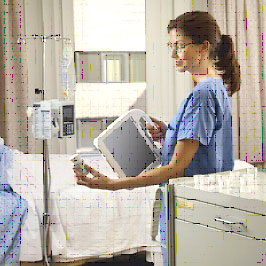
One of the most difficult areas for technology to address is the medication administration process. This is due to complex staff workflows and procedures – and in many cases, mandate compliance. A fundamental set of requirements that nurses must satisfy on a daily basis is embodied in the ‘five rights’: getting the right medication, in the right dose, using the right methodology, to the right patient at the right time. Errors in administering medication can have grave impacts on a patient’s health. There are the challenges for nurses of maintaining accuracy on long shifts while juggling multiple patients. Despite the importance of accuracy in meeting this set of requirements, nurses and other caregivers too often must rely upon hand-written orders from doctors, matched up to hand-written or printed ink patient wristbands.
Those wristbands may be partially illegible, and the manual transcription of data when they are made can introduce errors. Mismatching patients to the proper care can result in consequences such as incorrect medications or missed doses, use of the incorrect blood type, mixed-up pathology samples and incorrect surgical procedures (e.g., wrong parts of the body operated on or removed). Automatic identification technology complements and may eliminate the use of manual patient identification using somewhat unreliable wristbands, which can reduce the prevalence of errors and improve efficiency. It involves tracking the patient at every stage of their treatment, using a digital means of automatic identification that is machine-read and allows matching the actual patient to their medical chart and physician’s orders, plus non-medical aspects of their care such as meals and billing.
We have presented six areas of opportunity for hospitals to re-examine how they operate and offer more effective and efficient solutions to save costs and lives. Hospitals need to manage multiple business processes, just like any other business. This includes management of medical equipment, medication administration, tracking of blood and specimen and tracking patients from admission to discharge to optimize the patient flow.
We need to make these opportunities visible to hospital management, not only to smooth process flows, but to verify each process step and help prevent problems before they occur. It all starts with collecting relevant, real time information that allows you to analyze what is happening: identify errors, determine what and who are causing errors and then adjusting or modifying processes to resolve these issues. Hopefully we can assist the medical community with our expertise in providing real time visibility to operational and clinical processes and improve Patient Safety and quality of care and at the same time reduce costs and errors. We want to heal both the patient and the hospital and keep them both healthy.


